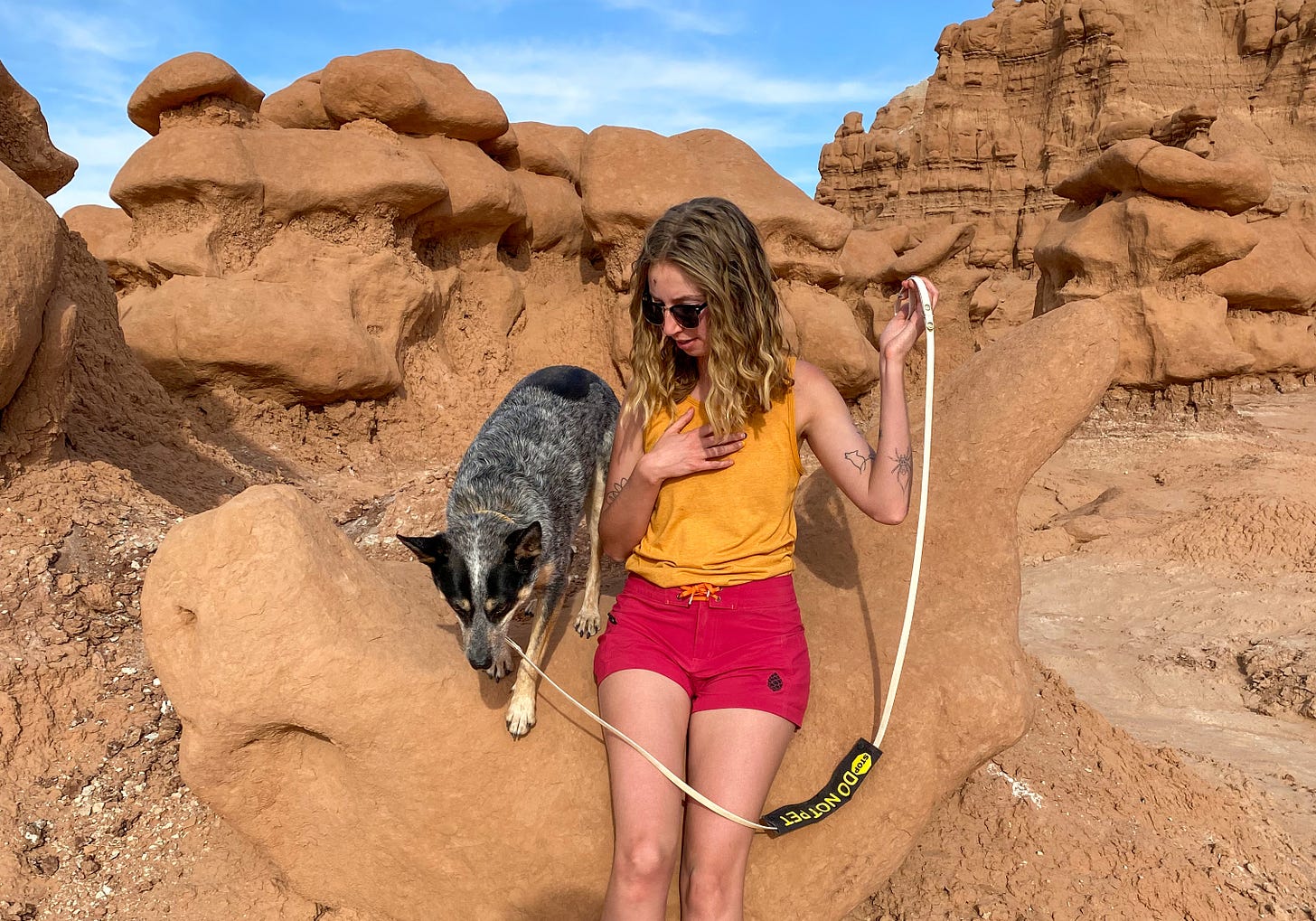Testing a dog's commitment to relaxation?
Plus favorite books, lots of writing updates, and deep love for the coast
I once saw a video of a shepherd lying at the feet of a dog trainer on a bench. The pair were practicing “sit on the dog” (a training protocol where you wait for your companion to settle without your guidance). Suddenly, the person stood up. Unsurprisingly, the dog did too—and the trainer verbally reprimanded him. They were “testing [the dog]’s commitment to relaxation”, the caption said.
I was, and remain, confused.
Proofing a formal down stay is one thing. If I tell Scout “down” and our command criteria—that I’ve taken time to clearly teach her—includes “enter and remain in position until told otherwise”? Then yes, me standing up quickly is a worthy distraction/temptation for her to resist. (We’ve worked hard on just that, actually: If my dog is on a place command at a patio or in a down under a park bench and I need to advocate for her space, it’s easier for everyone if she can stay still as I leap into action. Grabby toddlers and off-leash dogs come out of nowhere!)
But if Scout is at liberty—lying down of her own volition, not under command, with no instructions from me to do a specific thing—and I stand up quickly? Standing with me is the most natural reaction she could have.
And it’s what I want her to do as my fellow social creature.
This situation is not about a dog’s “commitment to relaxation”. (I’m skeptical of the focus the word commitment implies and whether it’s compatible with true relaxation at all, but that’s a whole other semantics conversation.) No, it’s about dogs navigating the world with us. Paying attention to our movements. Responding with their own.
Imagine you’re on a walk with your best friend. She whips her head around to look at something that caught her peripheral vision. What do you do? Probably turn to look too. Now she stops walking. What do you do? Probably also stop. We mirror each other constantly. Yale researchers say “following another’s gaze is a hallmark of human learning and socialization”.
Our dogs do it, too.
Domestic dogs understand when we are looking at something. (Think about how they drop toys within our view when they want to play fetch.) They pay attention to human pointing gestures from a young age. Our pets constantly attempt to interpret our body language—they start out attuned to us, a relic of our ancient interspecies bond, and grow more attuned as we learn each other as individuals over time.
I never want to “proof” that out of Scout. Seeing domestic dogs as social creatures uniquely suited to live with people has been the core transformation in my training and ownership journey. It isn’t folk nonsense to discuss the measurable, repeatable ways my dog responds to my own subtle cues. It isn’t dangerous anthropomorphism to talk about our relationship.
So if Scout and I are relaxing somewhere together and I suddenly stand up? She’s more than welcome to rise with me. If needed, I’ll give her further direction and put her under an official command. Otherwise, I’ll lean into the natural back-and-forth we’ve worked so hard to build after years of fixating too much on robotic, transactional interactions.
Notes and news
📚 The world is full of books
I spotted so many titles I love at Powell’s Books in Portland last week! Books by Sy Montgomery, Erica Berry, Katherine Rundell… the list goes on. I also added some new titles to my TBR, including Meet the Neighbors by Brandon Keim.
In case you missed it, Isabel Klee’s memoir, Dogs, Boys, and Other Things I’ve Cried About, is available for preorder. The cover reveal hit me in the heart. (It’s already a bestseller on Amazon and B&N!)
And Good Grief by E.B. Bartels comes out in paperback next month!
✍🏼 Other reading and writing
Sarah Kay was one of the first poets I loved, and she’s done it again in Suleika Jaouad’s latest newsletter: “The Minister of Loneliness”.
I recently found (and loved) Diana Hubbell’s writing via Off Assignment.
And I discovered The Auntie Bulletin by Lisa Sibbett here on Substack, which is already proving to be a home for so many things I’ve thought and felt.
Sub Club and The Forever Workshop are running a new challenge called First Draft November next month!
Last week was Courtney Maum’s Turning Points writing retreat, and I full-on stalked the program’s Instagram account for updates. (I harbor many fantasies about cold plunging and talking language with fellow writers like this. Anyone in??)
I’ve enjoyed Juliane Bergmann’s courses this fall, and I’ll be joining another soon with literary agent Tess Callero. Autumn is flying by and I have got to stop dragging my feet on finalizing query materials to make the Paws and Reflect book a reality.
🐺 Scout updates
I realized Scout hasn’t had a noticeable seizure in so long that I’ve been able to go weeks without consciously thinking about her epilepsy. Remind me to never ever ever take these good stretches for granted.
The dog culture in Oregon so far is… not very welcoming to people or pets who aren’t social butterflies. We are navigating more unsolicited off-leash encounters than basically anywhere we’ve been in ages. I’m thankful for our cattle gal’s recovery time and trust in us.
💛 Personal tidbits
We’re back by the ocean!! What a privilege it is to explore—and fall in love with—so many different places living in a van. What a joy it is to return to the waves for a morning swim.
In case you missed last week’s dog thoughts
In my early days on the dog-training internet, I felt preemptively defensive if I ever showed Scout doing something I knew other people’s dogs weren’t allowed to do. Now? I write gleeful posts about my dog’s lack of manners! (We call this growth, my friends.)








